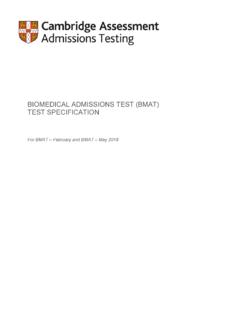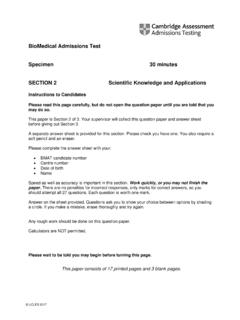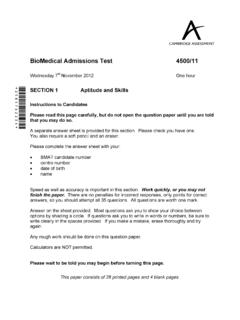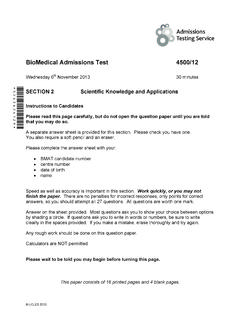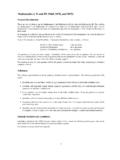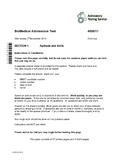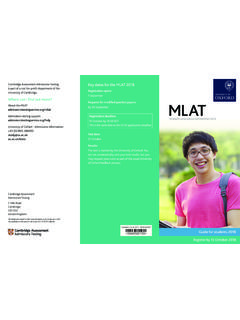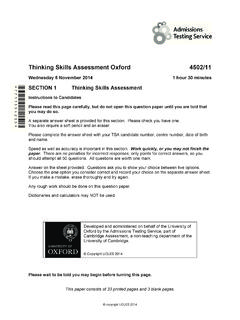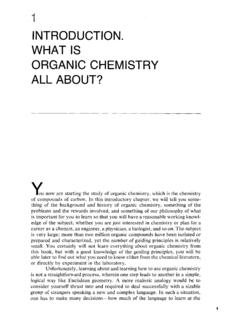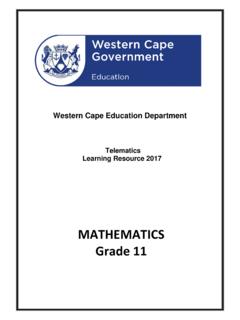Transcription of Test of Mathematics for University Admission test ...
1 Test of Mathematics for University Admission Specification for October 2019. Structure of the Test The test will consist of two 75 minute papers, taken one after the other. Each paper will consist of 20 multiple-choice questions. Questions across the two papers carry equal weight and there will be no penalty for incorrect answers, so candidates are advised to attempt all questions. There is no formulae booklet for this test; students are expected to understand and recall all relevant formulae. Candidates may not use calculators. The details of the papers are as follows: Paper 1: Mathematical Knowledge and Application Time: 75 minutes Content: 20 multiple-choice questions Requirements: Section 1 below This paper will test the candidate's ability to apply their mathematical knowledge in a variety of contexts. Candidates will be expected to know and use the mathematical content set out in Section 1 below. Paper 2: Advanced Mathematical Thinking Time: 75 minutes Content: 20 multiple-choice questions Requirements: Sections 1 and 2 below This paper will test the candidate's ability to apply their conceptual knowledge to constructing and analysing mathematical arguments.
2 For this paper candidates are expected to be familiar with the contents of Sections 1 and 2 below. UCLES 2019 2. SECTION 1. This section sets out the mathematical knowledge requirement for both papers of the test. The content of Part 1 is almost all covered within the pure Mathematics specification of an AS level in Mathematics , and the content of Part 2 is almost all covered within a Higher Level GCSE Mathematics course. There is some duplication of content across Parts 1 and 2. Candidates are advised to read through these specifications carefully to ensure they are aware of all topics and areas that might be covered in the test. Part 1. Algebra and functions AF1 Laws of indices for all rational exponents. AF2 Use and manipulation of surds; simplifying expressions that contain surds, including 5 3. rationalising the denominator; for example, simplifying , and . 3+2 5 7 2 3. AF3 Quadratic functions and their graphs; the discriminant of a quadratic function.
3 Completing the square; solution of quadratic equations. AF4 Simultaneous equations: analytical solution by substitution, of one linear and one quadratic equation. AF5 Solution of linear and quadratic inequalities. AF6 Algebraic manipulation of polynomials, including: Expanding brackets and collecting like terms;. Factorisation and simple algebraic division (by a linear polynomial, including those of the form + , and by quadratics, including those of the form 2 + + );. Use of the Factor Theorem and the Remainder Theorem. AF7 Qualitative understanding that a function is a many-to-one (or sometimes just a one- to-one) mapping. Familiarity with the properties of common functions, including ( ) = (which always means the positive square root') and ( ) = | |. Sequences and series SE1 Sequences, including those given by a formula for the th term and those generated by a simple recurrence relation of the form +1 = ( ). SE2 Arithmetic series, including the formula for the sum of the first natural numbers.
4 SE3 The sum of a finite geometric series; the sum to infinity of a convergent geometric series, including the use of | | < 1. SE4 Binomial expansion of (1 + ) for positive integer , and for expressions of the form . + ( ) for positive integer and simple ( ); the notations ! and . UCLES 2019 3. Coordinate geometry in the ( , ) plane CG1 Equation of a straight line, including 1 = ( 1 ) and + + = 0;. conditions for two straight lines to be parallel or perpendicular to each other; finding equations of straight lines given information in various forms. CG2 Coordinate geometry of the circle: using the equation of a circle in the forms ( )2 + ( )2 = 2 , and 2 + 2 + + + = 0. CG3 Use of the following circle properties: The perpendicular from the centre to a chord bisects the chord;. The tangent at any point on a circle is perpendicular to the radius at that point;. The angle subtended by an arc at the centre of a circle is twice the angle subtended by the arc at any point on the circumference.
5 The angle in a semicircle is a right angle;. Angles in the same segment are equal;. The opposite angles in a cyclic quadrilateral add to 180 ;. The angle between the tangent and chord at the point of contact is equal to the angle in the alternate segment. Trigonometry 1. TR1 The sine and cosine rules, and the area of a triangle in the form sin . 2. The sine rule includes an understanding of the ambiguous' case (angle-side-side). Problems might be set in 2- or 3-dimensions. TR2 Radian measure, including use for arc length and area of sector and segment. TR3 The values of sine, cosine, and tangent for the angles 0 , 30 , 45 , 60 , 90 . TR4 The sine, cosine, and tangent functions; their graphs, symmetries, and periodicity. sin . TR5 Knowledge and use of tan = and sin2 + cos2 = 1. cos . TR6 Solution of simple trigonometric equations in a given interval (this may involve the 1. use of the identities in TR5); for example: tan = 3 for < < ;.. 2 1 2.
6 Sin 2 + = for 2 < < 2 ; 12 cos + 6 sin 10 = 2 for 0 < < 360 . 3 2. UCLES 2019 4. Exponentials and Logarithms EL1 = and its graph, for simple positive values of . EL2 Laws of logarithms: = = log . log + log = log ( ).. log log = log .. log = log . including the special cases: 1. log = log .. log = 1. Questions requiring knowledge of the change of base formula will not be set. EL3 The solution of equations of the form = , and equations which can be reduced to this form, including those that need prior algebraic manipulation; for example, 32 =. 4 and 25 3 5 + 2 = 0. Differentiation DF1 The derivative of ( ) as the gradient of the tangent to the graph = ( ) at a point. In addition: Interpretation of a derivative as a rate of change;. Second-order derivatives;. 2 . Knowledge of notation: , , ( ), and ( ). 2. Differentiation from first principles is excluded. DF2 Differentiation of for rational , and related sums and differences. This might require some simplification before differentiating; for example, the ability to (3 +2)2.
7 Differentiate an expression such as 1 could be required. 2. DF3 Applications of differentiation to gradients, tangents, normals, stationary points (maxima and minima only), increasing [ ( ) 0 ] and decreasing [ ( ) 0 ]. functions. Points of inflexion will not be examined, although students are expected to have a qualitative understanding of points of inflexion in the curves of simple polynomial functions. UCLES 2019 5. Integration IN1 Definite integration as related to the area between a curve and an axis.' Candidates are expected to understand the difference between finding a definite integral and finding the area between a curve and an axis. Integrals could be given with respect to or with respect to . IN2 Finding definite and indefinite integrals of for rational, 1, and related sums and differences, including expressions which require simplification prior to (3 5)2. integrating; for example, ( + 2)2 , and 1 . 2. IN3 An understanding of the Fundamental Theorem of Calculus and its significance to integration.
8 Simple examples of its use may be required in the two forms, . ( ) = ( ) ( ), where ( ) = ( ), and ( ) = ( ). IN4 Combining integrals with either equal or contiguous ranges;. 5 5 5. for example, 2 ( ) + 2 ( ) = 2 [ ( ) + ( )] , 4 3 3. and 2 ( ) + 4 ( ) = 2 ( ) . IN5 Approximation of the area under a curve using the trapezium rule; determination of whether this constitutes an overestimate or an underestimate.. IN6 Solving differential equations of the form = ( ).. Graphs of Functions GF1 Recognise and be able to sketch the graphs of common functions that appear in this specification: these include lines, quadratics, cubics, trigonometric functions, logarithmic functions, exponential functions, square roots, and the modulus function. GF2 Knowledge of the effect of simple transformations on the graph of = ( ) as represented by = ( ), = ( ) + , = ( + ), = ( ), with the value of positive or negative. Compositions of these transformations. GF3 Understand how altering the values of and affects the graph of = +.
9 GF4 Understand how altering the values of , and in = ( + )2 + affects the corresponding graph. GF5 Use differentiation to help determine the shape of the graph of a given function; this might include finding stationary points (excluding inflexions) as well as finding when the function is increasing or decreasing. GF6 Use algebraic techniques to determine where the graph of a function intersects the coordinate axes; appreciate the possible numbers of real roots a general polynomial can possess. GF7 Geometric interpretation of algebraic solutions of equations; relationship between the intersections of two graphs and the solutions of the corresponding simultaneous equations. UCLES 2019 6. Part 2. Number Order, add, subtract, multiply and divide whole numbers, integers, fractions, decimals, and numbers in index form. Use the concepts and vocabulary of factor, multiple, common factor, highest common factor (hcf), least common multiple (lcm), composite ( not prime), prime number, and prime factor decomposition.
10 Use the terms square, positive and negative square root, cube and cube root. Use index laws to simplify, multiply, and divide integer, fractional, and negative powers. Interpret, order, and calculate with numbers written in standard index form. Understand equivalent fractions. Convert between fractions, decimals, and percentages. Understand and use percentage including repeated proportional change and calculating the original amount after a percentage change. Understand and use direct and indirect proportion. Use ratio notation including dividing a quantity in a given ratio, and solve related problems (using the unitary method). Understand and use number operations, including inverse operations and the hierarchy of operations. Use surds and in exact calculations; simplify expressions that contain surds, including rationalising the denominator. Calculate upper and lower bounds to contextual problems. Approximate to a specified and appropriate degree of accuracy, including rounding to a given number of decimal places or significant figures.
